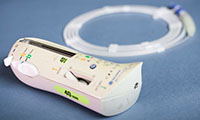Beta-Cath
The Beta-Cath™ System Saves Repeat Procedures and Patient Lives
Angioplasty has come a long way. In the early days of the procedure, stainless steel stents were used to keep the patient's artery from reclosing after the angioplasty balloon restored blood flow. But about a fifth of these patients developed restenosis—the growth of scar tissue in and around the stent. The results were chest pain, repeat procedures to reopen the clogged artery, and sometimes death from heart attack.
To remedy this situation, in the late 1990s Emory University physician/scientists Ian Crocker, MD, Spencer King, MD, Keith Robinson, PhD and Ron Waksman, MD along with engineers from Novoste Corporation, developed the Beta-Cath™ System, which uses vascular brachytherapy to prevent the artery from re-closing.

Ian Crocker, MD
With brachytherapy, tiny "seeds" of radiation are placed within the coronary artery at the site of the angioplasty, and are left in the artery for less than five minutes before being removed. The radioactive seeds minimize the growth of cells at the site, which reduces the amount of scar tissue that may develop. Patient's exposure is less than 1 percent of the radiation they would be exposed to by a typical chest X-ray.
The Beta-Cath™ System was licensed to Novoste and received FDA approval in 2000. It was the first commercially available vascular brachytherapy device in the U.S. and Europe. A few years later, Novoste received FDA approval for its smaller diameter Beta-Cath™ 3.5F System and its Beta-Cath™ System that uses a 60mm radiation source. The company also began clinical trials of its CORONA™ System for treatment of peripheral vascular disease and restenosis of arterial-venous dialysis grafts. In 2006, Novoste (now NOVT) sold all of its vascular brachytherapy assets to Best Vascular, Inc.

Beta-Cath Device
What sets Beta-Cath™ apart from other new technology, such as drug-eluting stents, is its proven track record. When standard stainless steel stents are used, 15 to 20 percent of patients experience restenosis as well as bouts of angina and chest pain. Drug-eluting stents, which are coated with medicines that interfere with reblocking, show a complication rate of 8 percent, while Beta-Cath™ has shown complication rates as low as 3.8 percent.
Fewer procedures mean less expense for the patient, less of a burden on the nation's health care system, and longer and better lives for patients. Beta-Cath™ is backed by data and the experience of interventional cardiologists, who have used it to treat more than 50,000 patients worldwide.
Additional Emory Publications on Beta-Cath™
Emory Report: Faculty receive funds to help commercialize research